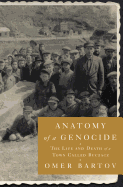
Buczacz (or Buchach), a town in Western Ukraine, was once a melting pot of Poles, Ukrainians and Jews. Under the Austro-Hungarian Empire, this simmering mix sometimes boiled over, but remained a relatively peaceful place. Today, this stagnant community of Soviet-era infrastructure is completely Ukrainian--made so through a century of horrific violence--whose history represents a microcosm of the Holocaust in Eastern Europe. Buczacz is a case study in how the Nazis used preexisting animosities for their genocidal ends, and why ethno-nationalism is a grave danger in any society.
Anatomy of a Genocide by Omer Bartov, a history professor at Brown University and author of multiple works on Nazi Germany and the Holocaust, began as a genealogical inquiry. Bartov's mother was raised in Buczacz, and though his research sprouted few new roots on his family tree, Bartov collected an enormous amount of information on the town's history. He outlines the region's centuries as a borderland battleground before turning to its terminal catastrophe, World War I, which sparked a long tamped powder keg of ethnic and religious hatred. As Galicia passed between Austria-Hungary, Poland, the Soviet Union, Nazi Germany and the Soviets again, lifelong neighbors in Buczacz turned against each other. When the Holocaust came, local Ukrainians and Poles had as much blood on their hands as the Nazis.
Anatomy of a Genocide is a grim but important examination of ethno-nationalism and anti-Semitism at their most destructive, and how these dark forces can be unleashed by political instability. --Tobias Mutter, freelance reviewer

